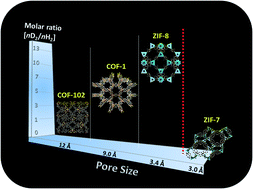Quantum cryo-sieving for hydrogen isotope separation in microporous frameworks: an experimental study on the correlation between effective quantum sieving and pore size†
Abstract
Different microporous frameworks have been experimentally investigated by cryogenic (below 77 K) hydrogen and deuterium adsorption measurements. The D2/H2 molar ratio is strongly dependent on pore size, pressure and temperature. The experiments clearly indicate that the optimum pore diameter for quantum sieving lies between 3.0 Å and 3.4 Å.


 Please wait while we load your content...
Please wait while we load your content...